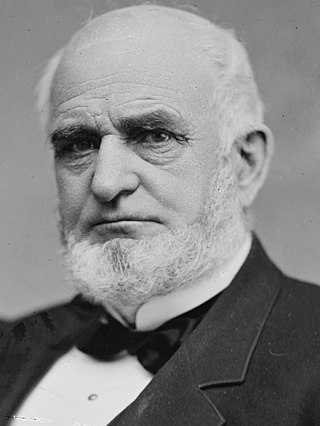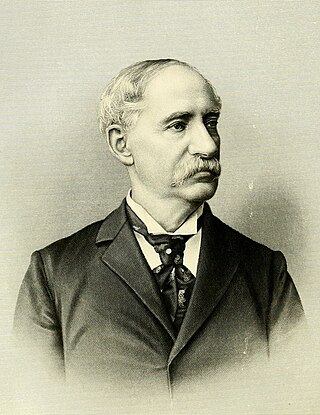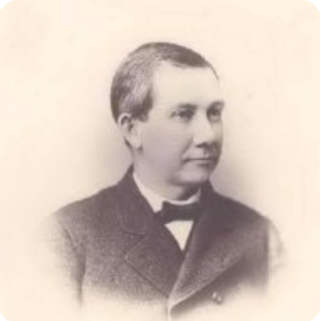Related Research Articles

Philetus Sawyer was an American businessman, Republican politician, and Wisconsin pioneer. He was a United States Senator from Wisconsin for twelve years (1881–1893) and served ten years in the U.S. House of Representatives (1865–1875). At the height of his power, Sawyer was described as one of the "triumvirate" of stalwart Wisconsin Republicans who dominated the state party in the latter part of the 19th century, the other triumvirs being U.S. senator John Coit Spooner and businessman Henry Clay Payne.

Gabriel Bouck was an American lawyer, Democratic politician, and Wisconsin pioneer. He represented Wisconsin in the United States House of Representatives for two terms. He also served as Wisconsin's 6th Attorney General and was the 24th speaker of the Wisconsin State Assembly. During the American Civil War he served as a Union Army officer.

Winnebago Mental Health Institute (WMHI), formerly the Winnebago State Hospital, is a psychiatric hospital near Oshkosh, Wisconsin, United States located in the unincorporated community of Winnebago, Wisconsin.

Frank Haderer (1859–1912) was an American hardware dealer from Milwaukee, Wisconsin, who served two terms as a Democratic member of the Wisconsin State Assembly from Milwaukee County.
The 18th Senate district of Wisconsin is one of 33 districts in the Wisconsin Senate. Located in east-central Wisconsin, the district comprises parts of northeast Winnebago County and southern Outagamie County. It includes the cities of Menasha and Neenah, most of the city of Appleton, and the northern half of the city of Oshkosh. It contains landmarks such as College Avenue Historic District, Lawrence University, and the University of Wisconsin–Oshkosh campus.
Charles Henry Larkin Sr., was an American merchant, real estate developer, and Wisconsin pioneer. He was a member of the Wisconsin State Senate (1866–1870) and State Assembly, representing southern Milwaukee County, and was sheriff of Milwaukee County in 1861 and 1862.
Benjamin Charles Garside was an American machinist from Milwaukee, Wisconsin who served one term as a People's Party member of the Wisconsin State Assembly.
Friedrich Vogel, more commonly known by the Americanized version of his name as Frederick Vogel, Sr., was an American tanner and businessman from Milwaukee, Wisconsin who spent a single one-year term as a member of the Wisconsin State Assembly. Together with Guido Pfister, he founded the Pfister & Vogel tannery.

Jacob Van Vechten Platto was an American lawyer, politician, and Wisconsin pioneer. He was a member of the Wisconsin State Assembly, representing the west side of the city of Milwaukee during the 1862 session. In historical documents, his name was often abbreviated as J. V. V. Platto, and his first name was sometimes incorrectly listed as "John".

Thomas Robert Wall was an American lumberman, banker, farmer and politician.
Joseph Seaver Curtis was an American lawyer, Republican politician, and Wisconsin pioneer. He was a member of the Wisconsin State Assembly for three terms, representing Green Bay and eastern Brown County during the 1869, 1871, and 1873 sessions. He was also an editor of the Green Bay Gazette, and an officer in the Union Army during the American Civil War.

John Bentley was a Welsh American immigrant, building contractor, Democratic politician, and Wisconsin pioneer. He was a member of the Wisconsin State Assembly, representing Milwaukee County in the 1863, 1878, 1879, and 1880 sessions. He also served as sheriff of Milwaukee County during the 1880s, and constructed many notable buildings of early Wisconsin. In historical documents, his last name was sometimes spelled Bently.

James Hervey Foster was an American farmer, Republican politician, and Wisconsin pioneer. He was a member of the Wisconsin State Senate and State Assembly, representing Winnebago County.
William Prentiss Rounds was an American businessman, Republican politician, and Wisconsin pioneer. He was a member of the Wisconsin State Senate and State Assembly, representing Winnebago County.

Carlton Foster was an American businessman, Republican politician, and Wisconsin pioneer. He was the 10th and 25th mayor of Oshkosh, Wisconsin, and served three terms in the Wisconsin State Assembly.

The 54th Assembly district of the Wisconsin is one of 99 districts in the Wisconsin State Assembly. Located in east-central Wisconsin, the district comprises part of eastern Winnebago County, including most of the city of Oshkosh, Wisconsin. It also contains landmarks such as the University of Wisconsin–Oshkosh campus, the Oshkosh campus of the Fox Valley Technical College, and the Oshkosh Corporation headquarters. The district is represented by Democrat Lori Palmeri, since January 2023.
Frederic Arthur Morgan was an American farmer and Republican politician. He was a member of the Wisconsin State Assembly, representing Oshkosh in the 1871 session. He was one of the first members of the Wisconsin Legislature to have been born in the territory of Wisconsin.

Samuel McClellan Hay was an American businessman, banker, Republican politician, and Wisconsin pioneer, prominent in the establishment and development of Oshkosh, Wisconsin. He was the fifth mayor of Oshkosh, and served one year each in the Wisconsin Senate (1862) and State Assembly (1858) representing Winnebago County. His name was often abbreviated as S. M. Hay.

The Sixty-Seventh Wisconsin Legislature convened from January 10, 1945, to September 6, 1945, in regular session, and reconvened in a special session in July 1946.

Henry Chapin Jewell was an American businessman, Republican politician, and Wisconsin pioneer. He was the 8th mayor of Oshkosh, Wisconsin, served two years as chairman of the Winnebago County board of supervisors, and represented Oshkosh in the Wisconsin State Assembly during the 1867 term. His name was often abbreviated as H. C. Jewell.
References
- 1 2 3 4 "Official Directory". The Legislative Manual of the State of Wisconsin (Report). State of Wisconsin. 1872. pp. 452–453 . Retrieved August 26, 2022.
- 1 2 "Official Directory". The Legislative Manual of the State of Wisconsin (Report). State of Wisconsin. 1870. p. . Retrieved August 26, 2022.
- 1 2 "Official Directory". The Legislative Manual of the State of Wisconsin (Report). State of Wisconsin. 1874. p. 464 . Retrieved August 26, 2022.
- ↑ "Total Destruction of Science Hall at Madison". Oshkosh Northwestern . December 2, 1884. p. 2. Retrieved August 26, 2022– via Newspapers.com.
- 1 2 3 "Biographical Sketches". The Blue Book of the State of Wisconsin (Report). State of Wisconsin. 1883. p. 498 . Retrieved August 26, 2022.
- 1 2 3 Bruce, William G.; Currey, J. Seymour (1922). History of Milwaukee City and County. Vol. 2. S. J. Clarke Publishing Co. p. 826 . Retrieved August 26, 2022.
- ↑ "Johann (John) Fellenz". Geni.com. Retrieved 2015-12-14.